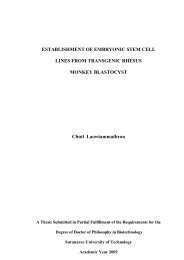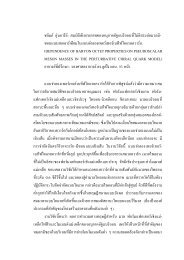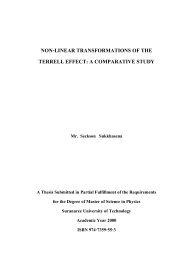PRODUCTION Of NUTRIENT SOURCES FOR RHIZOBIUM
PRODUCTION Of NUTRIENT SOURCES FOR RHIZOBIUM
PRODUCTION Of NUTRIENT SOURCES FOR RHIZOBIUM
You also want an ePaper? Increase the reach of your titles
YUMPU automatically turns print PDFs into web optimized ePapers that Google loves.
of sugar during fermentation resulted in significant increase in production of glycerol (Parekh and<br />
Pandey, 1985).<br />
Glycerol production from glucose using an osmophilic yeast, Pichia farinosa (ATCC<br />
20210), in an alkaline medium has been investigated in shake flasks. The amount, form, and mode of<br />
sodium carbonate addition have been found to affect the yield of glycerol, ethanol, and biomass.<br />
These effects are explained in terms of the critical parameters of pH and dissolved oxygen levels in<br />
the medium. Relatively high glycerol yields and concentrations coupled with rapid fermentations have<br />
been obtained (Vijaikishore and Karanth, 1987). Cells of the osmophilic yeast, P. farinosa, were<br />
immobilized in sintered glass rings for the production of glycerol (Bisping et al., 1990). The kinetics<br />
of production were observed under different conditions in batch, fed-batch and semicontinuous<br />
fermentations in fixed-bed column reactors and compared with those of free cells. Cells at the<br />
concentration of 2.6x10 9 cells/g sintered glass were adsorbed. The glycerol productivity was up to 8.1<br />
g/l per day. The highest concentration reached in batch culture was 86 g/l with immobilized cells<br />
(Bisping et al., 1990).<br />
Yeast strains were examined for their ability to produce glycerol. Kluyveromyces marxianus<br />
NRRLY-665 was chosen for optimization due to its comparatively high growth rate (0.5 h -1 ) and<br />
glycerol yield (9.5% by weight on lactose) at 37°C and pH 7. Optimal conditions for glycerol<br />
formation were 30-37°C and pH 6-7 (Rapin et al., 1994).<br />
Apiculate wine yeasts were studied for their ability to produce glycerol, acetaldehyde, ethyl<br />
acetate, sulphur dioxide and hydrogen sulfide in synthetic medium. Hanseniaspora guilliermondii<br />
produced smaller quantities of glycerol, acetaldehyde and hydrogen sulphide than Kloeckera<br />
apiculata. Selected strains of apiculate yeasts might favour an enhanced flavour formation and yield<br />
desirable characteristics to the final product (Romano et al., 1997).<br />
The production of L-iditol (iditol) from L-sorbose with D-sorbitol dehydrogenase coupled<br />
with NADH regeneration under methanol oxidation was studied with resting cell system of a<br />
methanol yeast, C. boidinii (Klockera sp.) No. 2201. The highest amount of iditol, 142-148 g/l (94-<br />
98% conversion rate), was obtained from 150 g/l of sorbose in the presence of 0.5 M methanol at pH<br />
6.5 (Vongsuvanlert and Tani, 1988). The production of erythritol by n-alkane-grown. C. zeylanoides<br />
��






